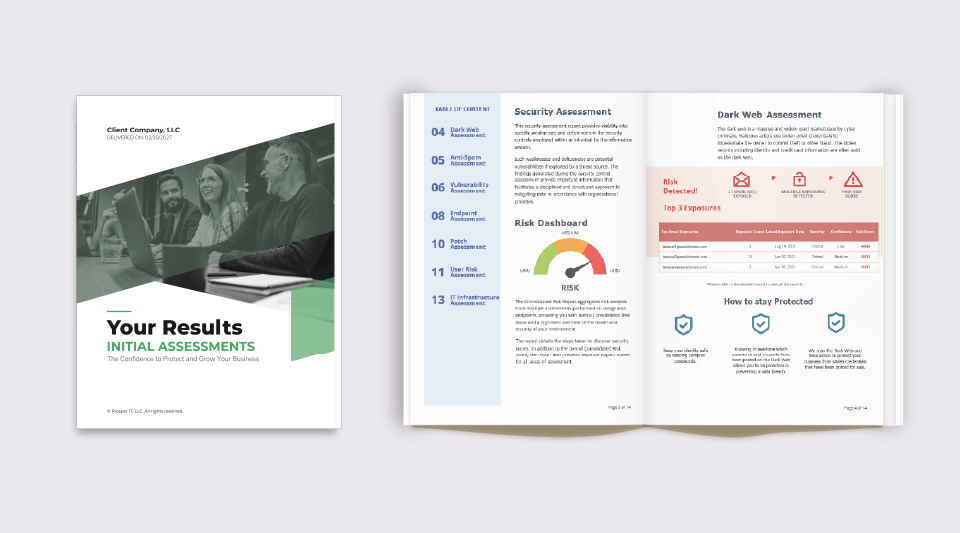IT Visibility: How to Protect and Grow Your Business
Do you ever feel “in the dark” about your company’s IT?
Maybe you’re frustrated by surprise outages that halt your operations, or you worry about lurking cyber threats you can’t see.
Perhaps your IT costs swing unpredictably each month, and it seems like you’re always paying to fix something.
It’s stressful – and you’re not alone.
Many business decision-makers share these pain points: a lack of visibility into their IT environment leaves them feeling vulnerable, blindsided by threats, and unsure if their technology is truly supporting their business goals.
In fact, downtime alone can be extraordinarily costly – studies have pegged the average cost as high as $5,600 to $9,000 per minute for businesses.
And beyond the dollars, there’s the nagging fear:
“What might be hiding in our systems right now that we don’t know about?“
Table of Contents
- Feeling the Pain: When You Can’t See, You Can’t Plan
- A Way Out of the Dark
-
What is an IT Visibility Assessment (in Plain English)?
- Dark Web Scan – Checking for Leaked Credentials on the “Hidden Internet”
- Vulnerability Report – Uncovering the “Holes” in Your Defenses
- Asset Lifecycle Status – Knowing What’s Old, What’s New, and What’s Due for Replacement
- Alignment Report – Making Sure IT and Business Are Marching in Sync
- Device Check – Ensuring Every Device is Secure, Healthy, and Accounted For
-
What is an IT Visibility Assessment (in Plain English)?
- Why Visibility Matters: The Strategic Big Picture
- Trust Through Transparency: Prosper IT’s Values and Approach
- Seeing is Believing – Take Control of Your IT Future
- Take the leap out of the dark.
Feeling the Pain: When You Can’t See, You Can’t Plan
Let’s start by acknowledging the reality: it’s hard to run a business when your IT feels like a black box. If you’re constantly firefighting IT issues or crossing your fingers that nothing major breaks, it’s a sign of poor visibility. Consider these common frustrations and why they happen:
Surprise Cyber Threats
You hear about another company in your industry getting hacked and think, “Are we next?” Without insight into your own vulnerabilities, it’s hard to know. It’s like locking your doors at night but not knowing if a window is wide open. Unseen weaknesses in your network (unpatched software, misconfigured systems, leaked passwords) are invitations to attackers. Alarmingly, about 60% of cyber breaches stem from known but unpatched vulnerabilities. If you’re not aware of these weak points, you can’t fix them – leaving your business exposed.

Unpredictable IT Costs

One month your IT spending is normal; the next, you’re hit with a massive bill to replace a failed server or recover from a malware incident. These surprises often occur when there isn’t a proactive plan. Think of it like neglecting car maintenance: skip the oil changes and you might end up with a blown engine. Lack of IT visibility means problems aren’t spotted early, so they explode into expensive emergencies. Plus, without a clear view of your IT assets, you might be overspending on outdated tech – pouring money into keeping old systems on life support.
Did you know outdated IT systems can increase maintenance budgets by around 15%? Old equipment breaks down more often and sucks up resources.) This reactive approach is not only costly but incredibly stressful.
Tech That Doesn’t Match Business Goals
Perhaps you invested in a fancy software platform that promised to revolutionize your operations – but a year later, it’s barely being used. Or your sales team complains that the new CRM doesn’t fit their process. This disconnect happens when IT decisions aren’t aligned with business strategy. It’s like having a map and a compass that point in different directions – you end up going nowhere. Without visibility into how each system supports (or hinders) your objectives, you risk misallocating resources. The result? Wasted budgets on tools that don’t solve your real problems, and missed opportunities to use technology as a true growth engine.
Fear of Compliance and Security Gaps
If your business handles sensitive data – customer information, credit card numbers, patient records – you know there are rules and regulations to follow (PCI, HIPAA, etc.). But compliance can feel like a moving target when you don’t have clarity on your IT setup. Are all our devices encrypted? Who has access to what data? Is anything “leaking” out into the wild? A lack of visibility here creates a feeling of vulnerability. You might worry that a surprise audit could turn up major issues, or worse, that you’re one weak password away from a breach and hefty fines.
Serious violations of standards like HIPAA can cost organizations up to $1.5 million per year– a frightening thought for any business owner.
A Way Out of the Dark
If any of these scenarios hit close to home, take a deep breath. There is a way out of the dark. It starts with getting a clear, comprehensive view of your IT – illuminating every corner so you can finally see what you’re working with. This is exactly what Prosper IT’s IT Visibility Assessment is designed to do.
What is an IT Visibility Assessment (in Plain English)?
Imagine a thorough check-up with a trusted doctor – but for your IT systems. Just as a doctor might do bloodwork, X-rays, and a blood pressure check to understand your overall health, an IT Visibility Assessment examines the critical aspects of your technology environment to diagnose issues and identify improvement opportunities. It’s not a high-pressure sales pitch or a technical interrogation. It’s a friendly, no-jargon review that gives you, the business leader, a clear picture of where you stand.
At Prosper IT, we consider this assessment the first and most important step toward fixing IT frustrations. Why? Because you can’t fix what you can’t see. The goal is to shine a light on all the things that matter in your IT – from security gaps to aging equipment – and deliver a straightforward game plan to make things safe, reliable, and aligned with your goals.
Let’s break down each component of this assessment and what it actually means for you:

Dark Web Scan – Checking for Leaked Credentials on the “Hidden Internet”
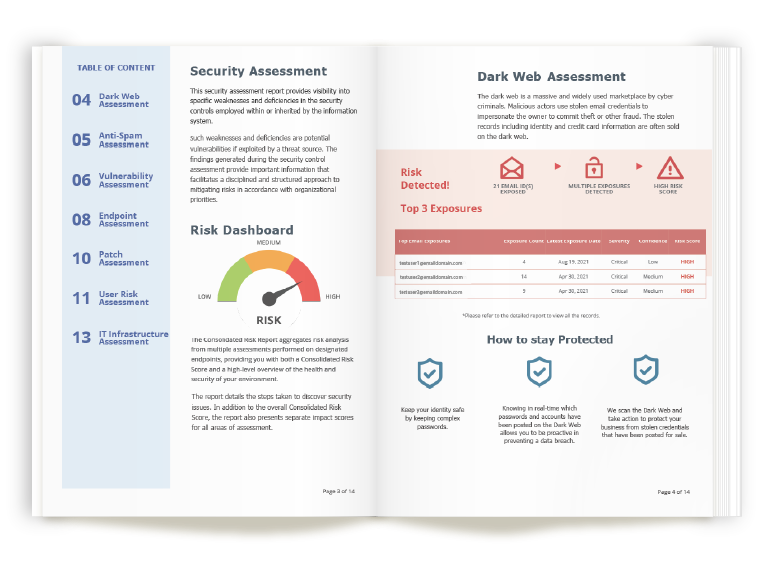
When hackers steal data from companies, that information often ends up for sale on the dark web (a part of the internet not indexed by Google, where cybercriminals operate). A Dark Web Scan is like sending a detective to scour those shady marketplaces to see if your company’s passwords or data have leaked out. For example, if an employee’s work email and password were exposed in a breach of some website, that could be a backdoor for attackers to access your systems. Discovering this early is crucial.
In non-technical terms, we look to see if your keys have fallen into the wrong hands. Prosper IT’s Dark Web Scan searches through databases of stolen credentials to spot any logins or sensitive info tied to your business. If we find something, we’ll alert you right away and help you take action (like changing passwords or enabling multi-factor authentication) to shut down potential intruders.
This check gives you peace of mind – or an early warning – about breaches that might have happened outside your organization but could impact you. It’s about knowing, not guessing, if your company’s data is floating around in risky places.
Vulnerability Report – Uncovering the “Holes” in Your Defenses
Think of your IT systems like a building. Over time, tiny cracks can appear – an unpatched server here, an outdated firewall there – and those cracks can let bad actors slip in. A Vulnerability Report is essentially a security sweep of your network, systems, and devices to identify those cracks (known as vulnerabilities) before attackers do.
In plain language, we look for weak spots in your IT setup – the kinds of weaknesses hackers love to exploit. This might include missing software updates, default or weak passwords, misconfigured settings, or anything known to be a security risk. As one definition puts it, a vulnerability assessment is the process of identifying and prioritizing security weaknesses in computer systems, applications, and network infrastructures. The result is a report that clearly highlights where you’re exposed.
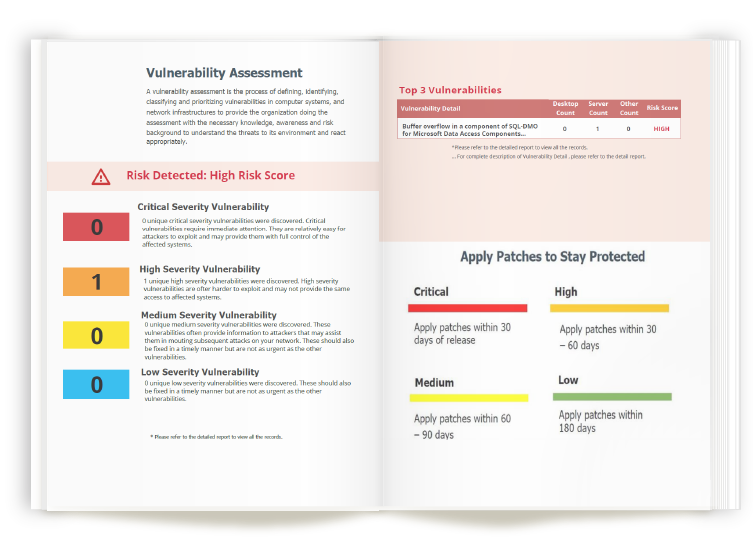
Why is this important? Imagine leaving the back door to your office unlocked every night – if you knew about it, you’d lock it immediately. Similarly, when the Vulnerability Report shows you a list of “unlocked doors and windows” in your IT, you can prioritize fixing them. This proactive approach beats waiting until after a cyberattack or costly incident occurs. It’s a lot cheaper (and far less painful) to fix a weak spot now than to clean up a security breach later. And remember that stat from before: a majority of breaches happen because of known vulnerabilities that weren’t addressed.
This report empowers you to stay ahead of threats rather than playing catch-up.
Asset Lifecycle Status – Knowing What’s Old, What’s New, and What’s Due for Replacement
Every piece of technology has a lifespan. Just like a car eventually becomes too unreliable (or too expensive to maintain), servers, computers, and software can reach a point where they’re no longer safe or efficient to use. The Asset Lifecycle Status portion of the assessment reviews all your key IT assets – hardware and software – to determine where each one is in its life cycle.

Why does this matter? Running mission-critical operations on outdated equipment is a recipe for trouble. Over time, old systems stop receiving security updates and vendor support. That means if a new cybersecurity threat emerges or something breaks, you’re on your own. As one industry expert notes, when software or hardware hits its end-of-life and loses support, it creates significant security vulnerabilities and risks of operational failure. In other words, an old server that’s out of support is akin to a ticking time bomb – it could fail unexpectedly or be exploited by hackers due to unpatched flaws.
During the assessment, Prosper IT will map out which of your assets are current, which are approaching end-of-life, and which should be retired or upgraded. We often find, for example, a company is still using PCs or operating systems that are years past their prime. This can lead to unplanned downtime and compliance issues (imagine the headache if that old database server crashes, or if it can’t pass a compliance audit because it’s no longer supported by the vendor). By getting a clear Asset Lifecycle Status, you’ll know in advance which tech components need attention. Think of it as your IT aging report: no more surprises – you can budget and plan for replacements on your terms, instead of dealing with emergency outages. Plus, updating aging tech can save money in the long run by reducing maintenance costs and improving efficiency. For example, employees lose considerable productivity on old slow machines – one study found small businesses lose 42 hours per year per employee on PCs older than 4 years.
“Small businesses lose 42 hours per year per employee on PCs older than 4 years.”
That’s a full work week of lost time, simply due to sluggish, outdated tech!)
Alignment Report – Making Sure IT and Business Are Marching in Sync
This part of the assessment steps back from the nuts and bolts (like security and hardware) and looks at the big picture strategy. An Alignment Report examines how well your current IT setup supports your business objectives and adheres to best practices or industry standards.
It answers questions like:
“Is our technology helping us reach our goals, or holding us back? Are we following proven best practices, or are there gaps?“
Prosper IT approaches this by evaluating your IT environment against over 300 industry best practices and standards.
That might sound technical, but what it really means is we’re checking your IT governance and strategy against what top organizations do to be successful. This includes looking at your policies, processes, and planning. For example, do you have a roadmap for future technology upgrades aligned with your growth plans? Are you prepared for disasters with a solid backup and recovery strategy? Are your systems compliant with any regulations your industry requires? An Alignment Report will highlight where things are well-aligned and where there are opportunities for improvement.
To put it simply, this is about connecting the dots between IT and your business. Without visibility here, it’s easy to overspend on technology that isn’t actually moving the needle. With the Alignment Report, you might discover, for instance, that you’re paying for a software subscription that nobody uses, or that your lack of a particular tool is causing inefficiencies in a key process. We’ve seen cases where a company’s IT was actually stifling growth – like a retail business that couldn’t implement online sales easily because their systems were too outdated and siloed. Once they aligned IT with their strategy (in this case, investing in a modern, cloud-based point of sale and inventory system), the business took off.
Alignment is where strategy meets reality: it ensures your tech investments are targeted to your business needs. As one IT visibility expert notes, having a clear view of your IT allows decision-makers to “identify opportunities for technology-driven innovation, optimize IT spending, and align IT resources with business objectives”.
In essence, your IT stops being a random collection of gadgets and starts being a coordinated engine that drives your company forward.
Device Check – Ensuring Every Device is Secure, Healthy, and Accounted For
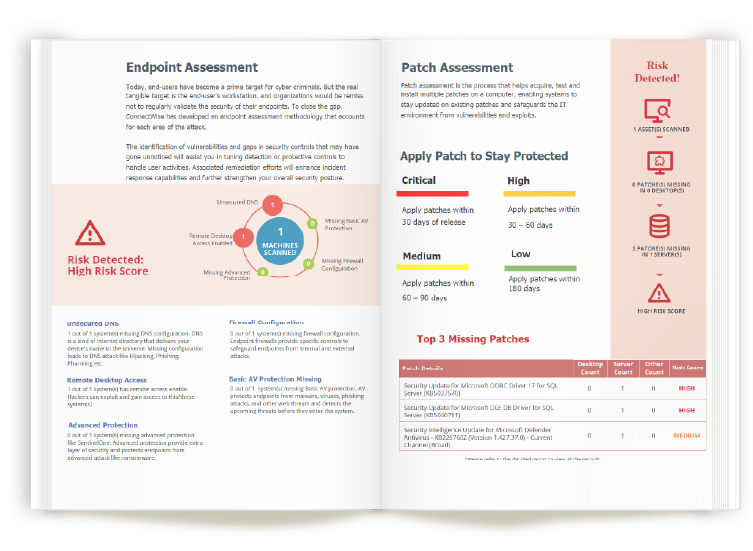
Last but not least, the IT Visibility Assessment includes a Device Check. Think of this as a thorough inventory and health inspection of all the endpoint devices that keep your business running day-to-day – PCs, laptops, printers, network gear, even smartphones or tablets if they’re company-issued. It’s easy for devices to fly under the radar, especially in a growing company. One day you hand out 10 new laptops to onboard employees; a year later, do you know if all of them are still updated and properly secured? Are there old company phones floating around with access to email? Are all those little devices (like that one PC in accounting nobody touches) being backed up and protected?
Device Check is about getting full visibility into every device and its status. We look at things like: Are antivirus and security patches up to date on each machine? Do any devices show signs of malfunction or impending failure (for example, a hard drive throwing errors)? Are all devices actually accounted for in the inventory, or do we have “rogue” devices on the network that IT wasn’t aware of? This might sound detail-oriented, but it’s extremely important. Every device is a potential entry point for trouble if not managed. A single forgotten laptop with an old password could become the weak link that a hacker exploits, or an old PC with a dying hard drive could crash and take important data with it.
By the end of this device audit, you’ll have a clear list of all your technology assets and their condition. For many business owners, this alone is a huge relief: “Finally, I know exactly what we have and if it’s protected.” No more mystery laptops or guessing how old that server in the corner is. And if the Device Check finds issues – say, a batch of computers hasn’t been getting updates properly – that’s actionable information. It’s far better to find out now and fix it (perhaps by enrolling those machines in a patch management system or replacing them if needed) than to learn the hard way via a security breach or failure. This is about preventing the preventable.
With strong device hygiene and tracking, you eliminate a lot of IT risk upfront.
Why Visibility Matters: The Strategic Big Picture
By now, you might be thinking, “This sounds like a lot of info – what do I do with it all?”
That’s a great question, and it touches on the core purpose of the IT Visibility Assessment. The aim isn’t to drown you in technical reports; it’s to give you actionable clarity. Each of the components we described comes with plain-language findings and recommendations. When you put them together, it forms a 360° view of your IT health. This is incredibly powerful.
Here’s why:
Informed Decision-Making
With the assessment results, you can finally make IT decisions based on facts, not guesses or sales hype. You’ll know what your most urgent risks are (maybe that old firewall that needs replacement ASAP), where you’re overspending, and where a small tweak could reap big benefits. For example, if the Dark Web Scan reveals compromised passwords, you can mandate a company-wide password reset and add two-factor authentication – immediately strengthening your security. If the Asset Lifecycle report shows a critical server hitting end-of-life next year, you can budget now for a replacement rather than scrambling later.
This transforms IT from a reactive fire-fighting effort to a proactive, strategic part of your business planning.
Foundation for a Long-Term IT Roadmap
Think of the assessment as laying the groundwork for a strategic plan. Prosper IT doesn’t just hand you the assessment and walk away. This is the first step in our partnership. Using the insights gathered, we work with you to develop a tailored Technology Plan and Roadmap going forward. This roadmap is essentially a prioritized to-do list for your IT – aligned with your business goals and timelines. For instance, it might outline immediate security fixes in the next 3 months, a major upgrade (like moving to a new cloud system) next quarter, and other improvements scheduled over a year or two. Importantly, anything that can’t be tackled right now goes into what we call an IT Maturity Roadmap – a living document that guides the evolution of your IT environment over time. This ensures nothing gets forgotten. As your business grows or changes, we revisit this roadmap (typically every quarter) to adjust priorities, add new initiatives, and keep things aligned.
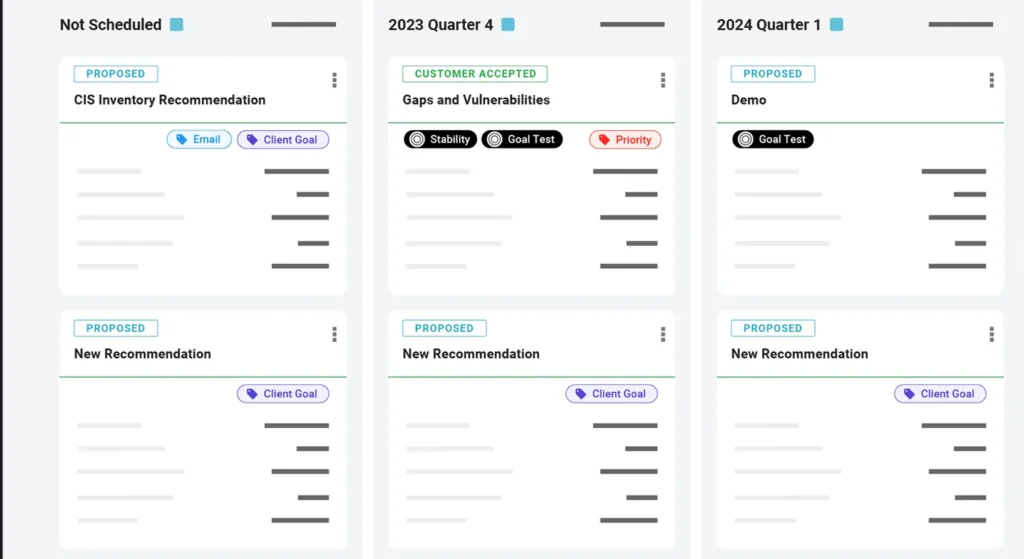
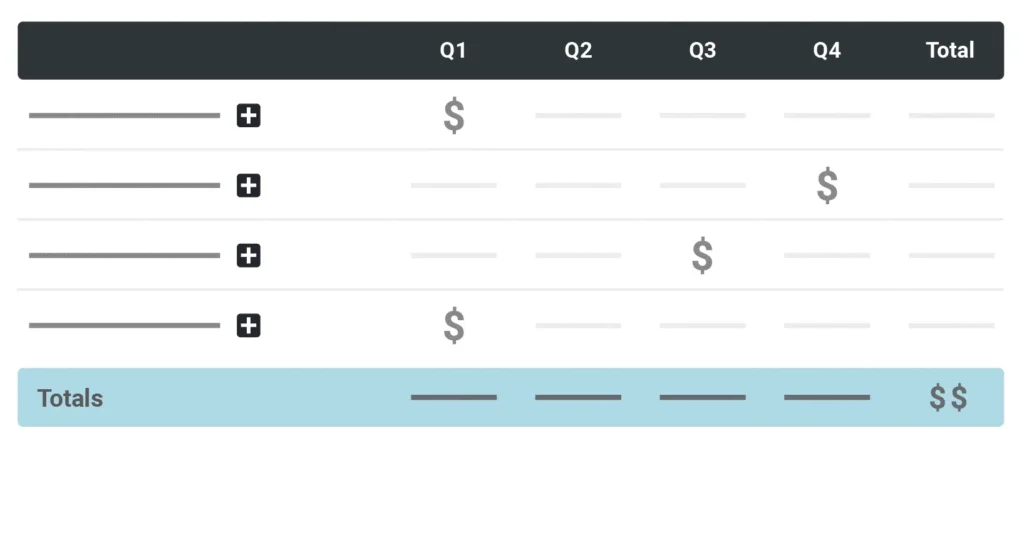
The key point: The visibility you gain today informs every step of your IT journey tomorrow. It’s the compass for all future IT decisions, big and small.
Proactive vs. Reactive IT Management
When you have visibility and a plan, you switch from “panic mode” to proactive mode. For example, instead of waiting until a device crashes, you’ve already identified it’s old and ordered a replacement in advance. Instead of hoping you’re secure, you’ve fixed the known vulnerabilities and set up monitoring for new ones. This shift is huge. It means far fewer emergencies, more predictable budgeting, and peace of mind knowing you’re not leaving things to chance. Prosper IT’s service model is built on this proactive philosophy – we want to prevent problems, not just fix them. That’s why after the assessment we often move into a managed IT services arrangement where we continuously monitor and maintain your environment, update that roadmap, and basically keep the lights on green. But none of that works without starting with proper visibility. As the old saying goes, “measure twice, cut once.” The IT Visibility Assessment is that careful measurement that makes every subsequent action more precise and effective.
Aligning IT with Business Success
Ultimately, visibility is not just about technology – it’s about your business. It’s about ensuring that every dollar you invest in IT has a purpose and returns value. With clear insight, you can align IT initiatives with business opportunities. Launching a new product line next quarter? Your IT roadmap (thanks to the assessment) already shows what’s needed to support it – say, additional cloud storage or a new software tool for the marketing team – so you’re not caught off guard. Without visibility, IT and business can feel like separate tracks; with it, they become one unified strategy.
“IT visibility enables organizations to align their IT services with business objectives, streamline operations, and deliver superior user experiences… allowing them to proactively address issues and minimize disruptions.”
In practice, this could mean happier customers because your systems are up and fast, or happier employees because they have the right tools that just work when they need them. It all ties back to seeing clearly where the gaps are and closing them in a planned way.
Trust Through Transparency: Prosper IT’s Values and Approach
You might be thinking, “This all sounds good, but I’ve seen IT consultants come in and hand me a big list of problems just to sell me stuff. How is this different?” The difference with Prosper IT comes down to our mission-driven, client-focused approach. We truly believe that trust is built through transparency and service. That belief is baked into how we conduct the IT Visibility Assessment and every step after.
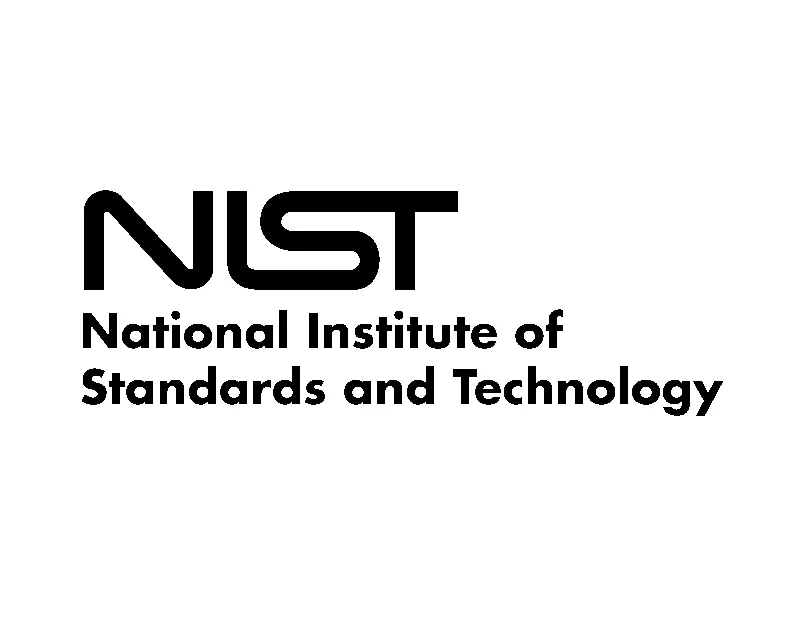
First, let’s talk credibility. Prosper IT doesn’t invent arbitrary checklists out of thin air – we base our assessment and recommendations on proven industry standards and frameworks. We align our process with guidelines from internationally recognized bodies like ISO 20000-1 (the gold standard for effective IT service management) and NIST (the National Institute of Standards and Technology’s cybersecurity framework, a widely adopted set of best practices for security). We also understand compliance frameworks such as PCI DSS (for payment card security) and HIPAA (for protecting patient health information).
What does this mean for you? It means the assessment isn’t just our opinion of what’s important – it’s grounded in what the broader industry and regulators consider important. We’re using the same measuring stick that Fortune 500 companies and respected institutions use to gauge IT health. If we say your password policy is weak or your data backup process needs improvement, you can be confident that’s not just subjective – it’s backed by established best practices and standards. This alignment with top standards is one reason our assessment is so comprehensive (remember those 300+ best practices we check against!).
We want you to know that our recommendations aren’t guesswork – they’re vetted against what works in the IT world.
Secondly, Prosper IT is a company with a heart and a mission. We were founded because our leadership hated seeing businesses treated like mere ticket numbers by impersonal IT providers. That frustration sparked a different way of doing business – one that is relational, not transactional. When we conduct an IT Visibility Assessment, it’s done with a spirit of partnership. We’re not here to point fingers or make you feel bad about the state of your tech. In fact, many of us at Prosper IT have sat on your side of the table in previous roles, so we empathize with the challenges.
Our goal is to empower you with knowledge and guide you to solutions that make sense for your unique situation. We take pride in being educators and advisors, not just fixers.
Finally, our client-focused service model means we tailor our engagement to your needs. The IT Visibility Assessment is highly accessible – it doesn’t matter if you’re a 5-person startup or a 500-person company, or whether you’re in healthcare, finance, manufacturing, or a local retail shop. We’ve designed the assessment to be scalable and relevant to any industry or size. Cyber threats and IT misalignment can affect anyone. The good news is that the solutions are also accessible to anyone. We deliver the assessment findings in plain language, with clear priorities. We’ll sit down with you (in-person or via a screen-share) to walk through everything, answer your questions, and frankly, teach you what it all means.
Our clients often tell us that even this review meeting is an eye-opener…
“Ah, I finally understand what’s going on with our IT!”
We love hearing that, because it means we’ve succeeded in our mission of bringing clarity where there was confusion.
And remember, there are no dumb questions in this process. If we mention something like “patch management” or “ISO standard” and you’re not familiar, we’ll explain it without jargon or ego. We’re on your team, and part of that is making sure you feel confident and informed. By building this trust and demonstrating our expertise (in a friendly way), we hope to earn the right to be your long-term IT partner.
Whether or not you choose to continue with Prosper IT’s services beyond the assessment, you will have gained valuable insights and a clearer path forward. That’s our promise: you’ll get value, not vague fluff.
Seeing is Believing – Take Control of Your IT Future
It’s time to stop flying blind with your IT. You don’t have to live with that gnawing uncertainty, those surprise breakdowns, or the feeling that your technology is a step behind your business needs. Visibility is the first step to victory. When you can see clearly, you can plan clearly, act decisively, and sleep more soundly at night knowing there are no lurking IT disasters waiting to pounce. The IT Visibility Assessment offered by Prosper IT is a straightforward, accessible way to get that clarity and confidence.
Imagine a few weeks from now: you’re sitting down with a concise report and a knowledgeable advisor walking you through it. You’re nodding along because, finally, it all makes sense – this is why the network was slow (and here’s how we’ll fix it), that’s which devices are out of date (and here’s the upgrade plan), here’s proof of where our security stands (and specific steps to bolster it). Instead of vague worries, you have concrete information and a clear path forward. That’s the power of an IT Visibility Assessment. It shines a light on the dark corners and turns on the headlights, so you can confidently steer your business without fear of unseen obstacles.
No matter your company’s size or tech savviness, you deserve to have control over your IT environment rather than it controlling you. Prosper IT is here to guide you on that journey, with empathy, expertise, and an unwavering commitment to your success. We’ve got the tools, the team, and the heart to help you transform your IT from a source of frustration into a driver of growth and security.

Ready to take the first step? It all begins with a simple conversation. We invite you to reach out and book a 15-minute Clarity Call – a no-obligation chat where we can discuss your situation and explain how the IT Visibility Assessment would work for you. In just a quarter of an hour, you’ll gain preliminary insights and get a feel for our consultative, no-pressure approach. This could very well be the most productive 15 minutes you spend on your business this year. Don’t let uncertainty keep you up at night or hold your company back. Embrace visibility, take control, and let’s chart a course for an IT environment that is secure, efficient, and perfectly aligned with where you want your business to go.
Take the leap out of the dark.
Schedule your Clarity Call today, and take the first step into leveraging IT to protect and grow your business.

